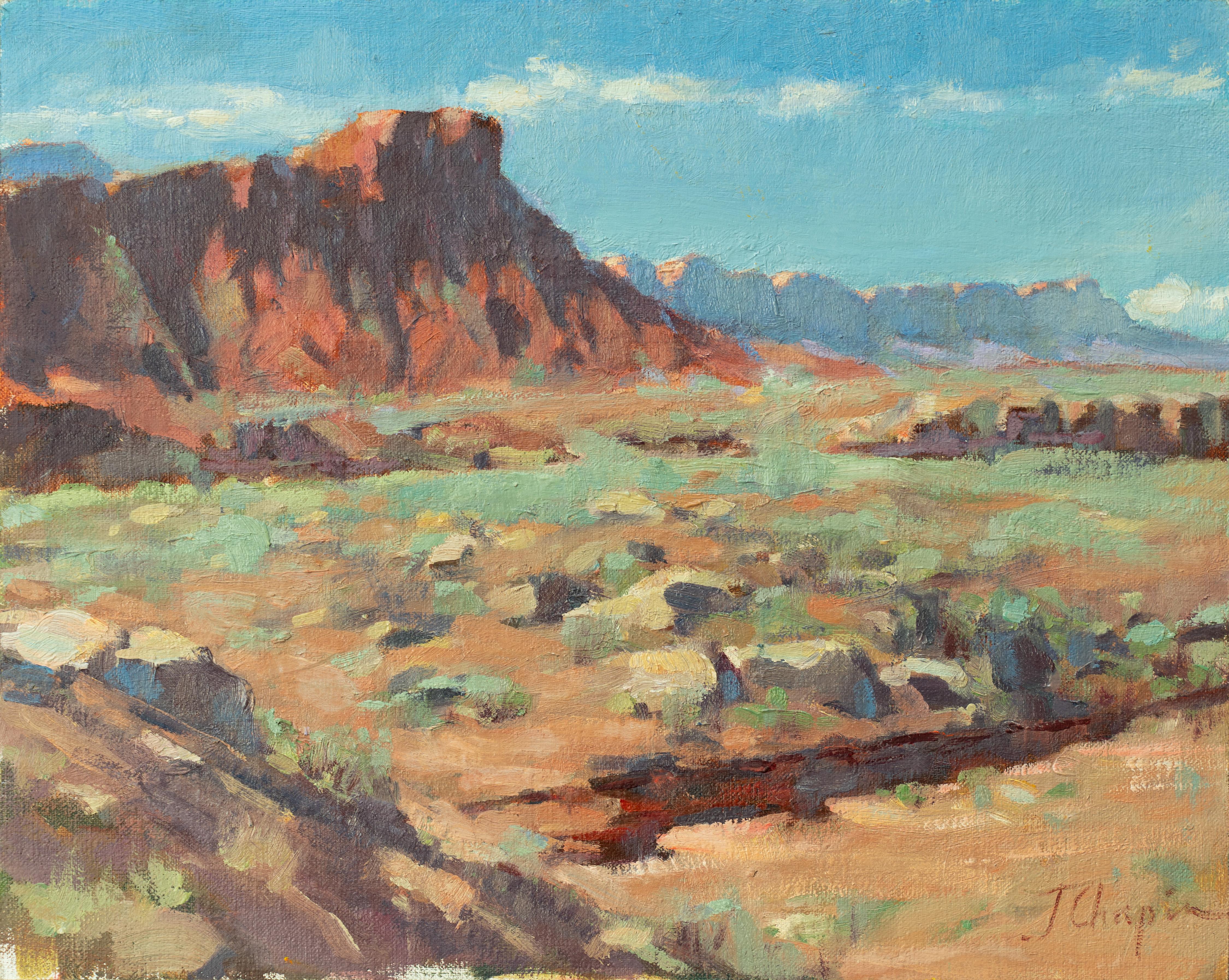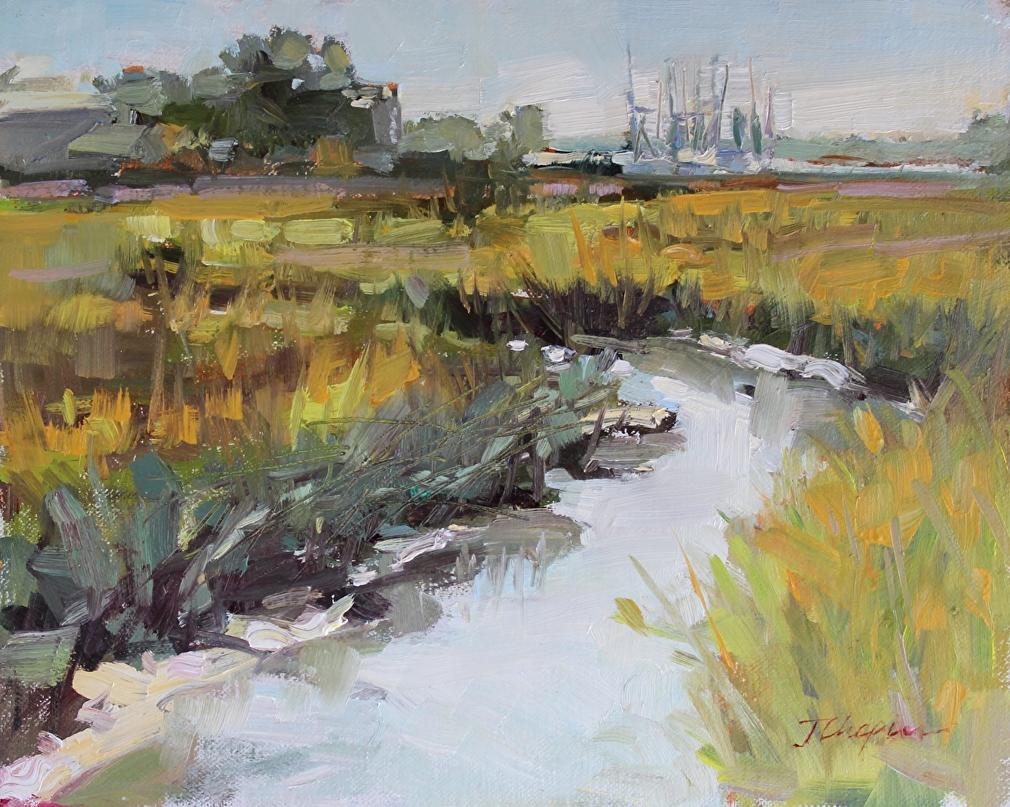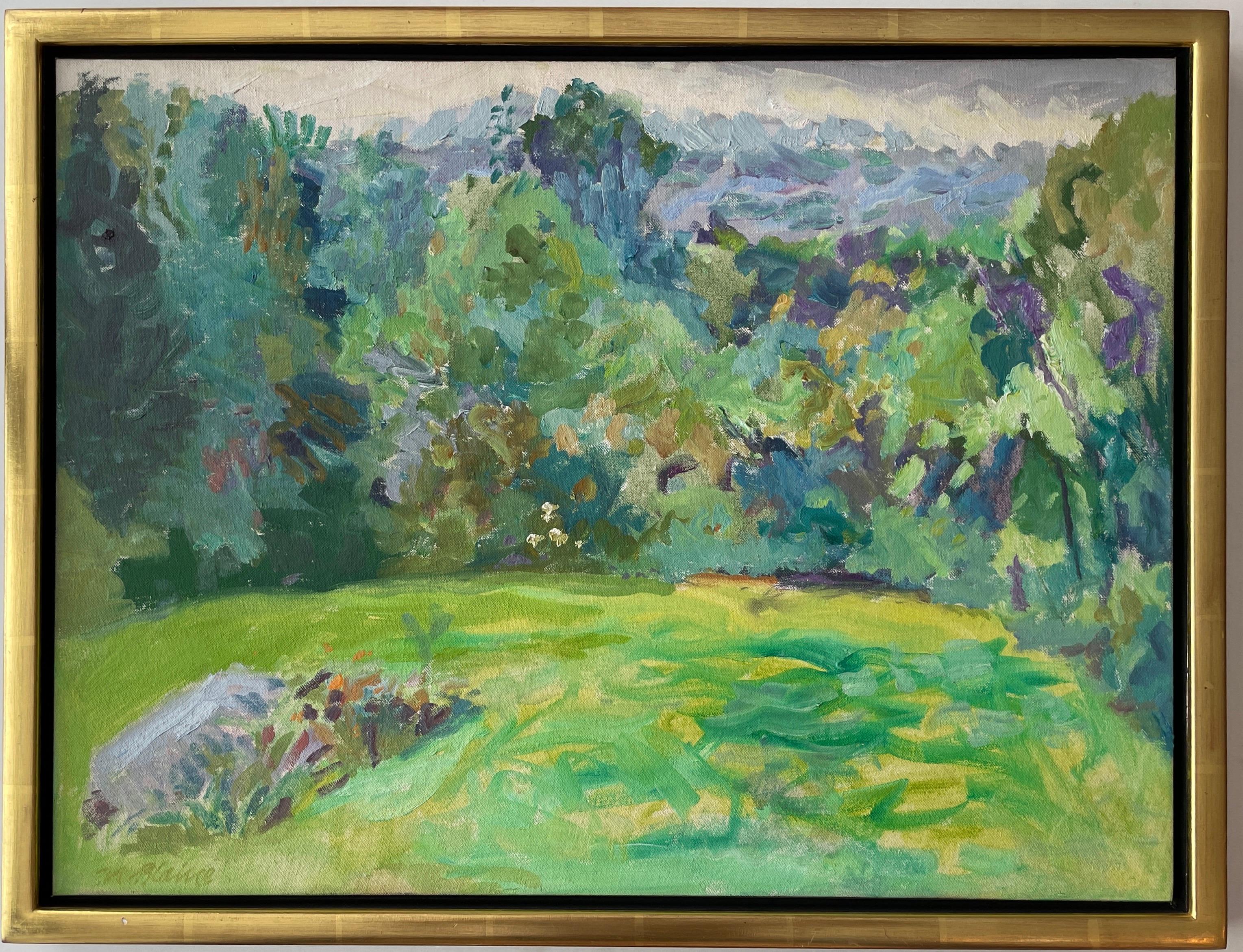Items Similar to "Bellosguardo (Florence, Italy)"
Want more images or videos?
Request additional images or videos from the seller
1 of 4
Daniel Garber"Bellosguardo (Florence, Italy)"1905
1905
About the Item
Jim’s of Lambertville Fine Art Gallery is proud to present this piece by Daniel Garber (1880 - 1958).
One of the two most important and, so far, the most valuable of the New Hope School Painters, Daniel Garber was born on April 11, 1880, in North Manchester, Indiana. At the age of seventeen, he studied at the Art Academy of Cincinnati with Vincent Nowottny. Moving to Philadelphia in 1899, he first attended classes at the "Darby School," near Fort Washington; a summer school run by Academy instructors Anshutz and Breckenridge. Later that year, he enrolled at the Pennsylvania Academy of the Fine Arts. His instructors at the Academy included Thomas Anshutz, William Merritt Chase and Cecilia Beaux. There Garber met fellow artist Mary Franklin while she was posing as a model for the portrait class of Hugh Breckenridge. After a two year courtship, Garber married Mary Franklin on June 21, 1901.
In May 1905, Garber was awarded the William Emlen Cresson Scholarship from the Pennsylvania Academy, which enabled him to spend two years for independent studies in England, Italy and France. He painted frequently while in Europe, creating a powerful body of colorful impressionist landscapes depicting various rural villages and farms scenes; exhibiting several of these works in the Paris Salon.
Upon his return, Garber began to teach Life and Antique Drawing classes at the Philadelphia School of Design for Women in 1907. In the summer of that same year, Garber and family settled in Lumbertville, Pennsylvania, a small town just north of New Hope. Their new home would come to be known as the "Cuttalossa," named after the creek which occupied part of the land. The family would divide the year, living six months in Philadelphia at the Green Street townhouse while he taught, and the rest of the time in Lambertville. Soon Garber’s career would take off as he began to receive a multitude of prestigious awards for his masterful Pennsylvania landscapes. During the fall of 1909, he was offered a position to teach at the Pennsylvania Academy as an assistant to Thomas Anshutz. Garber became an important instructor at the Academy, where he taught for forty-one years.
Daniel Garber painted masterful landscapes depicting the Pennsylvania and New Jersey countryside surrounding New Hope. Unlike his contemporary, Edward Redfield, Garber painted with a delicate technique using a thin application of paint. His paintings are filled with color and light projecting a feeling of endless depth. Although Like Redfield, Garber painted large exhibition size canvases with the intent of winning medals, and was extremely successful doing so, he was also very adept at painting small gem like paintings. He was also a fine draftsman creating a relatively large body of works on paper, mostly in charcoal, and a rare few works in pastel. Another of Garber’s many talents was etching. He created a series of approximately fifty different scenes, most of which are run in editions of fifty or less etchings per plate.
Throughout his distinguished career, Daniel Garber was awarded some of the highest honors bestowed upon an American artist. Some of his accolades include the First Hallgarten Prize from the National Academy in 1909, the Bronze Medal at the International Exposition in Buenos Aires in 1910, the Walter Lippincott Prize from the Pennsylvania Academy and the Potter Gold Medal at the Art Institute of Chicago in 1911, the Second Clark Prize and the Silver Medal from the Corcoran Gallery of Art for “Wilderness” in 1912, the Gold Medal from the Panama-Pacific Exposition in San Francisco of 1915, the Second Altman Prize in1915, the Shaw prize in 1916, the First Altman Prize in 1917, the Edward Stotesbury Prize in1918, the Temple Gold Medal, in 1919, the First William A. Clark Prize in 1921, the Gold Medal from the Philadelphia Art Club in 1923, the Carnegie Institute Bronze Medal in 1924, the Gold Medal of Honor in 1929, the Jenny Sesnan Gold Medal in 1937, the Pennell Medal in 1942, and the Pennsylvania Academy Fellowship Award in1947 among many others.
Daniel Garber and Edward Redfield are known by most art enthusiasts as the two leading figures associated with the New Hope Art Colony. This is a correct assessment, but in the broader scope, as key figures in twentieth century American Art, their importance is equally paramount. As this group, once considered regional, secures it’s place in history, painters like Garber and Redfield are destined to be considered the true American Masters by the international art world.
Garber's work is included in nearly thirty museum collections nationally and this number is growing. He is also the first of the "New Hope School" painters to exceed the million dollar mark at auction which occurred in 2003.
- Creator:Daniel Garber (1880-1958, American)
- Creation Year:1905
- Dimensions:Height: 9.5 in (24.13 cm)Width: 13 in (33.02 cm)
- More Editions & Sizes:Framed Size 19.5" x 23"Price: $111,875
- Medium:
- Movement & Style:
- Period:
- Condition:
- Gallery Location:Lambertville, NJ
- Reference Number:
About the Seller
5.0
Vetted Seller
These experienced sellers undergo a comprehensive evaluation by our team of in-house experts.
Established in 1997
1stDibs seller since 2014
36 sales on 1stDibs
Typical response time: 6 hours
- ShippingRetrieving quote...Ships From: Lambertville, NJ
- Return PolicyThis item cannot be returned.
More From This SellerView All
- "Autumn, New Hope"By John Wells JamesLocated in Lambertville, NJJim’s of Lambertville is proud to offer this artwork. Signed lower right. Complemented by a hand carved and gilt frame. John Wells James (1873 - 1951) A master of both landscape and still life painting, Brooklyn-born John Wells James was a significant member of the New Hope...Category
20th Century American Impressionist Landscape Paintings
MaterialsOil, Board
- "Sleigh Ride"By John R. GrabachLocated in Lambertville, NJJim’s of Lambertville is proud to offer this artwork. Signed lower right. Complemented by a hand carved and gilt frame. John R. Grabach (1886 - 1981) John Grabach was a highly...Category
20th Century American Impressionist Landscape Paintings
MaterialsOil, Board
- "Study for Lone House"By John R. GrabachLocated in Lambertville, NJJim’s of Lambertville is proud to offer this artwork. Signed lower center. Complemented by hand carved frame. John R. Grabach (1886 - 1981) John Grabach was a high...Category
20th Century American Impressionist Landscape Paintings
MaterialsOil, Board
- "City Scene"By Hayley LeverLocated in Lambertville, NJJim’s of Lambertville is proud to offer this artwork. Signed and dated March 1943 lower right. Hayley Lever (1876 - 1958) Hayley Lever's exceptional career path took him from th...Category
1940s American Impressionist Landscape Paintings
MaterialsOil, Board
- "Canal Bend"By Evelyn FahertyLocated in Lambertville, NJJim’s of Lambertville is proud to offer this artwork. Signed lower right. Evelyn Faherty (1919-2015) Evelyn Faherty was born in the early 20th century and made her home in Yardley, Pennsylvania. She is a Bucks County Impressionist...Category
20th Century American Impressionist Landscape Paintings
MaterialsOil, Board
- "The Delaware Canal"By Alice B. SotterLocated in Lambertville, NJJim’s of Lambertville is proud to offer this artwork. Complemented by a Ben Badura Frame Illustrated in "New Hope for American Art" page 499 Signed lo...Category
20th Century American Impressionist Landscape Paintings
MaterialsOil, Board
You May Also Like
- Vermillion at Lee's Ferry ( Plein Air Landscape painting sky blue terracotta)By Jane ChapinLocated in Cody, WYThis is a 'Plein Air" landscape Painting by Jane Chapin as seen in the viewing room exhibition on Silas VON MORISSE GALLERY. “Plein-Air” is the French expression to describe the act of painting in situ within the landscape, capturing the ever changing weather and light with tonal qualities, colour, loose brushwork and softness of form... The practice of “Plein Air Painting” goes back for centuries but was truly made into an art form by the French Impressionists such as Claude Monet, Camille Pissarro, Alfred Sisley, and Pierre-Auguste Renoir who were advocating of plein air painting. Much of their work was done outdoors in the diffuse light of a large white umbrella. Another major proponent of Plein Air was Jean Baptiste Camille Corot whom Claude Monet considered as “The only One Master here”. Corot provides a transition from the sharp academic style that ruled in his day with focus on the natural world and the lyrical expressiveness of one's work. With her "Plein Air Paintings", Jane Chapin is part of one of the largest art movements in history. Her paintings carry human emotions. We can read her moods and feelings with places that carry deep remembrances for the artist that go beyond the descriptive. "My paintings grow from observing and interpretating light as it emerges from, surrounds and reflects on everyday people and scenes. They seek to remind us of the beauty of our common surroundings, regardless of where we are." - Jane Chapin Jane Chapin Painting the Land of the Free...Category
2010s American Impressionist Landscape Paintings
MaterialsLinen, Oil, Board
- Pecos Temple (Plein Air landscape Painting - beige neutral colors)By Jane ChapinLocated in Cody, WYThis is a 'Plein Air" landscape Painting by Jane Chapin as seen in the viewing room exhibition on Silas VON MORISSE GALLERY. “Plein-Air” is the French expression to describe the act...Category
2010s American Impressionist Landscape Paintings
MaterialsLinen, Oil, Board
- Coming In & Going Out ( Plein Air Landscape painting green yellow colors)By Jane ChapinLocated in Cody, WYThis is a 'Plein Air" landscape Painting by Jane Chapin as seen in the viewing room exhibition on Silas VON MORISSE GALLERY. “Plein-Air” is the French expression to describe the act of painting in situ within the landscape, capturing the ever changing weather and light with tonal qualities, colour, loose brushwork and softness of form... The practice of “Plein Air Painting” goes back for centuries but was truly made into an art form by the French Impressionists such as Claude Monet, Camille Pissarro, Alfred Sisley, and Pierre-Auguste Renoir who were advocating of plein air painting. Much of their work was done outdoors in the diffuse light of a large white umbrella. Another major proponent of Plein Air was Jean Baptiste Camille Corot whom Claude Monet considered as “The only One Master here”. Corot provides a transition from the sharp academic style that ruled in his day with focus on the natural world and the lyrical expressiveness of one's work. With her "Plein Air Paintings", Jane Chapin is part of one of the largest art movements in history. Her paintings carry human emotions. We can read her moods and feelings with places that carry deep remembrances for the artist that go beyond the descriptive. "My paintings grow from observing and interpretating light as it emerges from, surrounds and reflects on everyday people and scenes. They seek to remind us of the beauty of our common surroundings, regardless of where we are." - Jane Chapin Jane Chapin Painting the Land of the Free...Category
2010s American Impressionist Landscape Paintings
MaterialsLinen, Oil, Board
- Storm Over Assateague ( Plein Air Landscape painting light green yellow blues)By Jane ChapinLocated in Cody, WYThis is a 'Plein Air" landscape Painting by Jane Chapin as seen in the viewing room exhibition on Silas VON MORISSE GALLERY. “Plein-Air” is the French expression to describe the act...Category
2010s American Impressionist Landscape Paintings
MaterialsLinen, Oil, Board
- Summer, Quaker Hill oil painting by Nell BlaineBy Nell BlaineLocated in Hudson, NYThis work by Nell Blaine was exhibited at the Poindexter Gallery, as well as the Tibor de Nagy Gallery, both in New York City. It is signed lower left, and signed, titled, and dated ...Category
1960s American Impressionist Landscape Paintings
MaterialsOil, Board
- Oil Landscape of Cape Cod MassachusettsBy Aldro Thompson HibbardLocated in Fredericksburg, VAThis is a beautiful Cape Cod Massachusetts spring landscape with a rural farm and water behind it was painted by American artist Aldro Thompson Hibbard (1886-1972). Hibbard was born in Falmouth, Vermont and later became one of the founders of the Rockport Art Colony, living on Cape Ann in Massachusetts and summering in Jamaica, Vermont. Trained at the Boston Museum School, Hibbard carried forth the tenets of traditional academic art into the 20th century. He became very well-known for his New England...Category
Mid-20th Century American Impressionist Landscape Paintings
MaterialsOil, Board
Recently Viewed
View AllMore Ways To Browse
People Gathering
Edward Paul
Fauvist Oil Painting
Vintage Autumn Paintings
South Pacific
Harry Somers
Porter Artist
Relaxing Art
Modern Southwest Art
Arizona Oil Landscape
Evening Sky
Western Native American Paintings
Antique Ornate Painting Frames
Ford Canvas
Fords Canvas
Antique British Landscape
Landscape North Carolina
1996 Art Board




